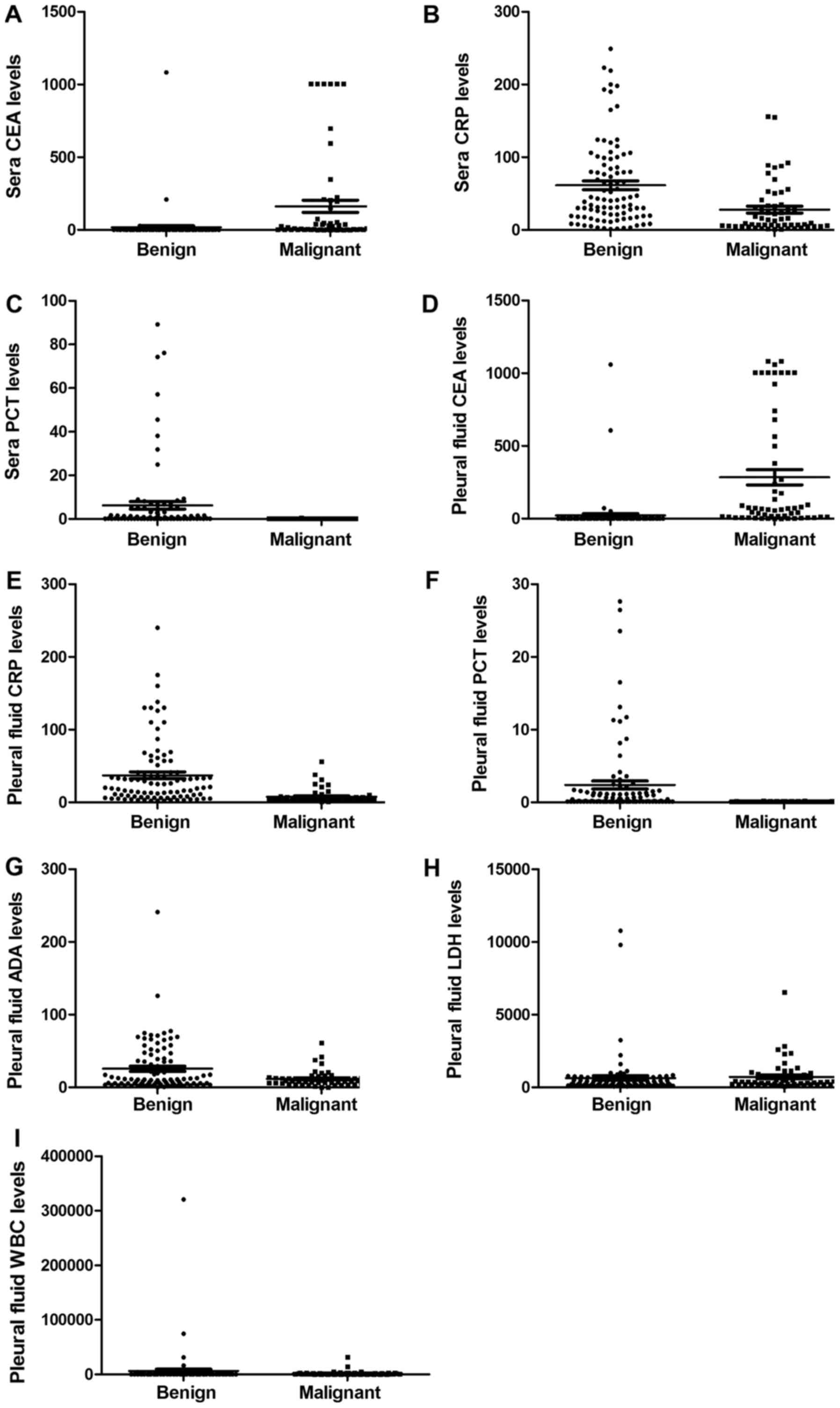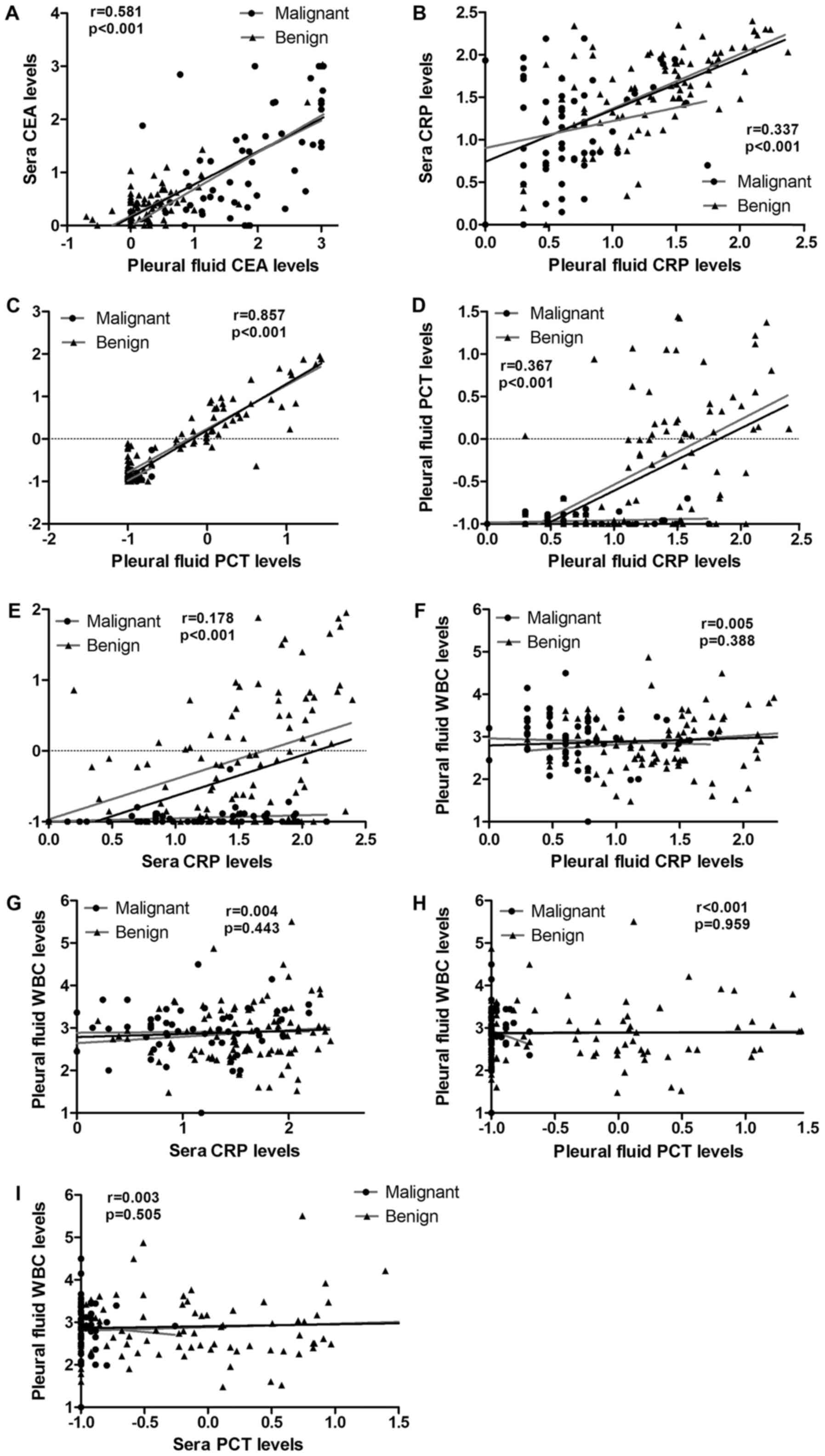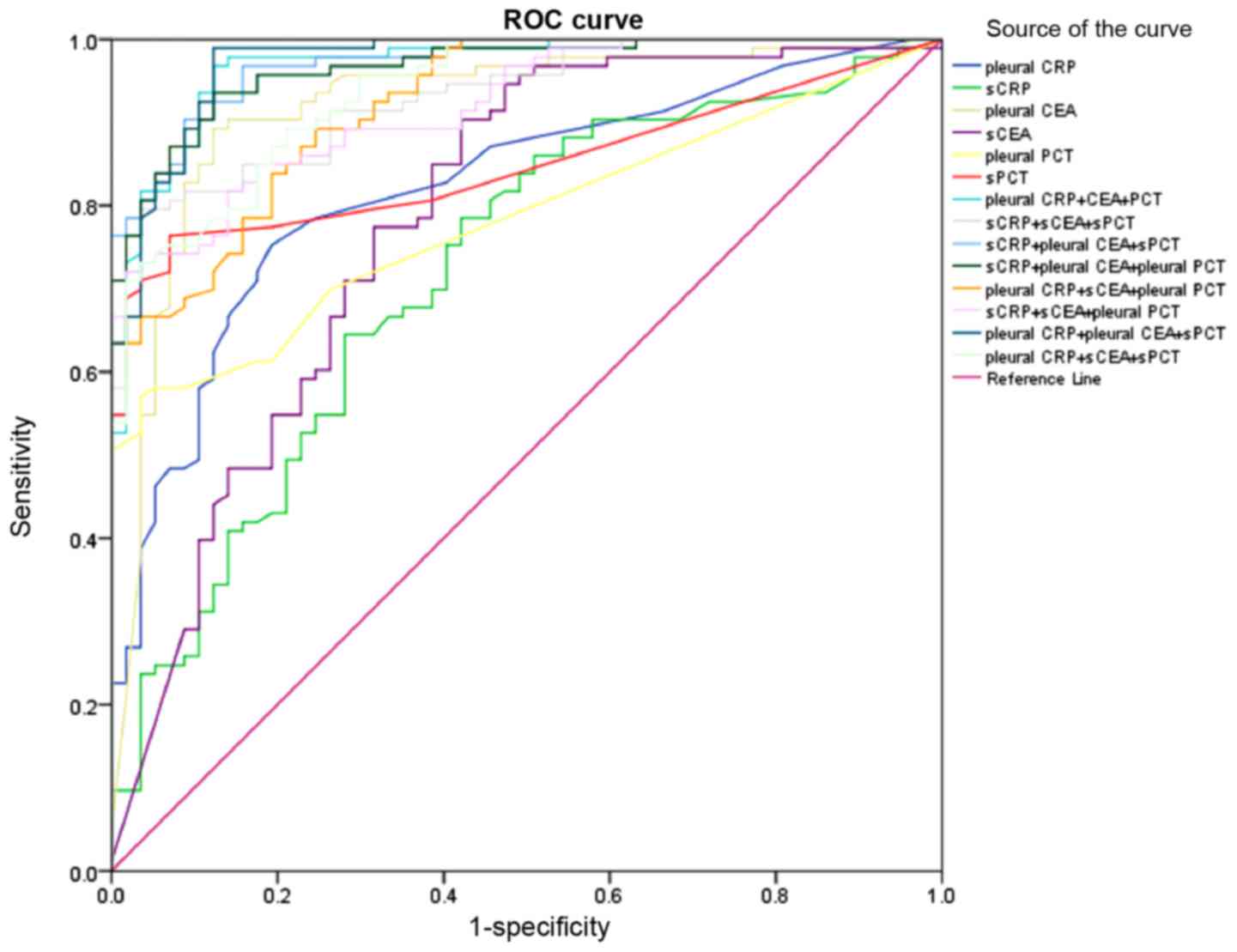|
1
|
Braunschweig T, Chung JY, Choi CH, Cho H,
Chen QR, Xie R, Perry C, Khan J and Hewitt SM: Assessment of a
panel of tumor markers for the differential diagnosis of benign and
malignant effusions by well-based reverse phase protein array.
Diagn Pathol. 10:532015. View Article : Google Scholar : PubMed/NCBI
|
|
2
|
Maskell NA and Butland RJ; Pleural
Diseases Group, Standards of Care Committee, British Thoracic
Society: BTS guidelines for the investigation of a unilateral
pleural effusion in adults. Thorax. 58(Suppl 2): ii8–ii17. 2003.
View Article : Google Scholar : PubMed/NCBI
|
|
3
|
Yoon DW, Cho JH, Choi YS, Kim J, Kim HK,
Zo JI and Shim YM: Predictors of survival in patients who underwent
video-assisted thoracic surgery talc pleurodesis for malignant
pleural effusion. Thorac Cancer. 7:393–398. 2016. View Article : Google Scholar : PubMed/NCBI
|
|
4
|
Porcel JM, Vives M, Esquerda A, Salud A,
Pérez B and Rodríguez-Panadero F: Use of a panel of tumor markers
(carcinoembryonic antigen, cancer antigen 125, carbohydrate antigen
15-3, and cytokeratin 19 fragments) in pleural fluid for the
differential diagnosis of benign and malignant effusions. Chest.
126:1757–1763. 2004. View Article : Google Scholar : PubMed/NCBI
|
|
5
|
Catarino PA and Goldstraw P: The future in
diagnosis and staging of lung cancer: Surgical techniques.
Respiration. 73:717–732. 2006. View Article : Google Scholar : PubMed/NCBI
|
|
6
|
Gu P, Huang G, Chen Y, Zhu C, Yuan J and
Sheng S: Diagnostic utility of pleural fluid carcinoembryonic
antigen and CYFRA 21-1 in patients with pleural effusion: A
systematic review and meta-analysis. J Clin Lab Anal. 21:398–405.
2007. View Article : Google Scholar : PubMed/NCBI
|
|
7
|
Liang QL, Shi HZ, Qin XJ, Liang XD, Jiang
J and Yang HB: Diagnostic accuracy of tumour markers for malignant
pleural effusion: A meta-analysis. Thorax. 63:35–41. 2008.
View Article : Google Scholar : PubMed/NCBI
|
|
8
|
Ryu JS, Lee HJ, Cho JH, Han HS and Lee HL:
The implication of elevated carcinoembryonic antigen level in
pleural fluid of patients with non-malignant pleural effusion.
Respirology. 8:487–491. 2003. View Article : Google Scholar : PubMed/NCBI
|
|
9
|
Alataş F, Alataş O, Metintaş M, Colak O,
Harmanci E and Demir S: Diagnostic value of CEA, CA 15-3, CA 19-9,
CYFRA 21-1, NSE and TSA assay in pleural effusions. Lung Cancer.
31:9–16. 2001. View Article : Google Scholar : PubMed/NCBI
|
|
10
|
Villena V, López-Encuentra A,
Echave-Sustaeta J, Martín-Escribano P, Ortuño-de-Solo B and
Estenoz-Alfaro J: Diagnostic value of CA 549 in pleural fluid.
Comparison with CEA, CA 15.3 and CA 72.4. Lung Cancer. 40:289–294.
2003.
|
|
11
|
Shitrit D, Zingerman B, Shitrit AB, Shlomi
D and Kramer MR: Diagnostic value of CYFRA 21-1, CEA, CA 19-9, CA
15-3, and CA 125 assays in pleural effusions: Analysis of 116 cases
and review of the literature. Oncologist. 10:501–507. 2005.
View Article : Google Scholar : PubMed/NCBI
|
|
12
|
Lee JH and Chang JH: Diagnostic utility of
serum and pleural fluid carcinoembryonic antigen, neuron-specific
enolase, and cytokeratin 19 fragments in patients with effusions
from primary lung cancer. Chest. 128:2298–2303. 2005. View Article : Google Scholar : PubMed/NCBI
|
|
13
|
Mehanic S and Baljic R: The importance of
serum procalcitonin in diagnosis and treatment of serious bacterial
infections and sepsis. Mater Sociomed. 25:277–281. 2013. View Article : Google Scholar : PubMed/NCBI
|
|
14
|
Uzzan B, Cohen R, Nicolas P, Cucherat M
and Perret GY: Procalcitonin as a diagnostic test for sepsis in
critically ill adults and after surgery or trauma: A systematic
review and meta-analysis. Crit Care Med. 34:1996–2003. 2006.
View Article : Google Scholar : PubMed/NCBI
|
|
15
|
Nijsten MW, Olinga P, The TH, de Vries EG,
Koops HS, Groothuis GM, Limburg PC, ten Duis HJ, Moshage H,
Hoekstra HJ, et al: Procalcitonin behaves as a fast responding
acute phase protein in vivo and in vitro. Crit Care Med.
28:458–461. 2000. View Article : Google Scholar : PubMed/NCBI
|
|
16
|
Wacker C, Prkno A, Brunkhorst FM and
Schlattmann P: Procalcitonin as a diagnostic marker for sepsis: A
systematic review and meta-analysis. Lancet Infect Dis. 13:426–435.
2013. View Article : Google Scholar : PubMed/NCBI
|
|
17
|
Brunkhorst R, Eberhardt OK, Haubitz M and
Brunkhorst FM: Procalcitonin for discrimination between activity of
systemic autoimmune disease and systemic bacterial infection.
Intensive Care Med. 26(Suppl 2): S199–S201. 2000. View Article : Google Scholar : PubMed/NCBI
|
|
18
|
Joo K, Park W, Lim MJ, Kwon SR and Yoon J:
Serum procalcitonin for differentiating bacterial infection from
disease flares in patients with autoimmune diseases. J Korean Med
Sci. 26:1147–1151. 2011. View Article : Google Scholar : PubMed/NCBI
|
|
19
|
Buhaescu I, Yood RA and Izzedine H: Serum
procalcitonin in systemic autoimmune diseases-where are we now?
Semin Arthritis Rheum. 40:176–183. 2010. View Article : Google Scholar : PubMed/NCBI
|
|
20
|
Kim SE: Serum procalcitonin is a candidate
biomarker to differentiate bacteremia from disease flares in
patients with inflammatory bowel disease. Gut Liver. 10:491–492.
2016. View
Article : Google Scholar : PubMed/NCBI
|
|
21
|
Wang CY, Hsiao YC, Jerng JS, Ho CC, Lai
CC, Yu CJ, Hsueh PR and Yang PC: Diagnostic value of procalcitonin
in pleural effusions. Eur J Clin Microbiol Infect Dis. 30:313–318.
2011. View Article : Google Scholar : PubMed/NCBI
|
|
22
|
Yang Y, Xie J, Guo F, Longhini F, Gao Z,
Huang Y and Qiu H: Combination of C-reactive protein, procalcitonin
and sepsis-related organ failure score for the diagnosis of sepsis
in critical patients. Ann Intensive Care. 6:512016. View Article : Google Scholar : PubMed/NCBI
|
|
23
|
Izhakian S, Wasser WG, Fox BD,
Vainshelboim B and Kramer MR: The diagnostic value of the pleural
fluid C-reactive protein in parapneumonic effusions. Dis Markers.
2016:75397802016. View Article : Google Scholar : PubMed/NCBI
|
|
24
|
Xu C, Yu L, Zhan P and Zhang Y: Elevated
pleural effusion IL-17 is a diagnostic marker and outcome predictor
in lung cancer patients. Eur J Med Res. 19:232014. View Article : Google Scholar : PubMed/NCBI
|
|
25
|
Antonangelo L, Sales RK, Corá AP, Acencio
MM, Teixeira LR and Vargas FS: Pleural fluid tumour markers in
malignant pleural effusion with inconclusive cytologic results.
Curr Oncol. 22:e336–e341. 2015. View Article : Google Scholar : PubMed/NCBI
|
|
26
|
Li H, Huang L, Tang H, Zhong N and He J:
Pleural fluid carcinoembryonic antigen as a biomarker for the
discrimination of tumor-related pleural effusion. Clin Respir J.
11:881–886. 2017. View Article : Google Scholar : PubMed/NCBI
|
|
27
|
Gaspar MJ, de Miguel J, García Díaz JD and
Díez M: Clinical utility of a combination of tumour markers in the
diagnosis of malignant pleural effusions. Anticancer Res.
28:2947–2952. 2008.PubMed/NCBI
|
|
28
|
Molina R, Bosch X, Auge JM, Filella X,
Escudero JM, Molina V, Solé M and López-Soto A: Utility of serum
tumor markers as an aid in the differential diagnosis of patients
with clinical suspicion of cancer and in patients with cancer of
unknown primary site. Tumour Biol. 33:463–474. 2012. View Article : Google Scholar : PubMed/NCBI
|
|
29
|
Miédougé M, Rouzaud P, Salama G, Pujazon
MC, Vincent C, Mauduyt MA, Reyre J, Carles P and Serre G:
Evaluation of seven tumour markers in pleural fluid for the
diagnosis of malignant effusions. Br J Cancer. 81:1059–1065. 1999.
View Article : Google Scholar : PubMed/NCBI
|
|
30
|
Blasi F, Stolz D and Piffer F: Biomarkers
in lower respiratory tract infections. Pulm Pharmacol Ther.
23:501–507. 2010. View Article : Google Scholar : PubMed/NCBI
|
|
31
|
Castelli GP, Pognani C, Meisner M, Stuani
A, Bellomi D and Sgarbi L: Procalcitonin and C-reactive protein
during systemic inflammatory response syndrome, sepsis and organ
dysfunction. Crit Care. 8:R234–R242. 2004. View Article : Google Scholar : PubMed/NCBI
|
|
32
|
Meidani M, Khorvash F, Abolghasemi H and
Jamali B: Procalcitonin and quantitative C-reactive protein role in
the early diagnosis of sepsis in patients with febrile neutropenia.
South Asian J Cancer. 2:216–219. 2013. View Article : Google Scholar : PubMed/NCBI
|
|
33
|
Magrini L, Travaglino F, Marino R, Ferri
E, de Berardinis B, Cardelli P, Salerno G and Di Somma S:
Procalcitonin variations after Emergency Department admission are
highly predictive of hospital mortality in patients with acute
infectious diseases. Eur Rev Med Pharmacol Sci. 17(Suppl 1):
S133–S142. 2013.
|

















